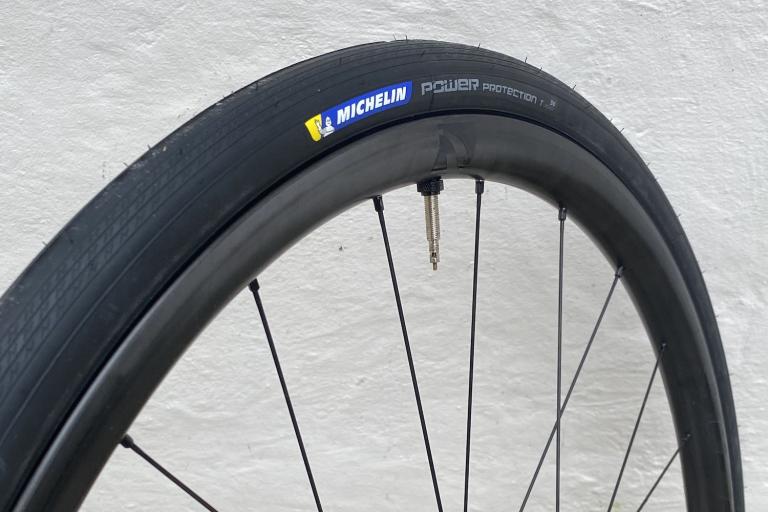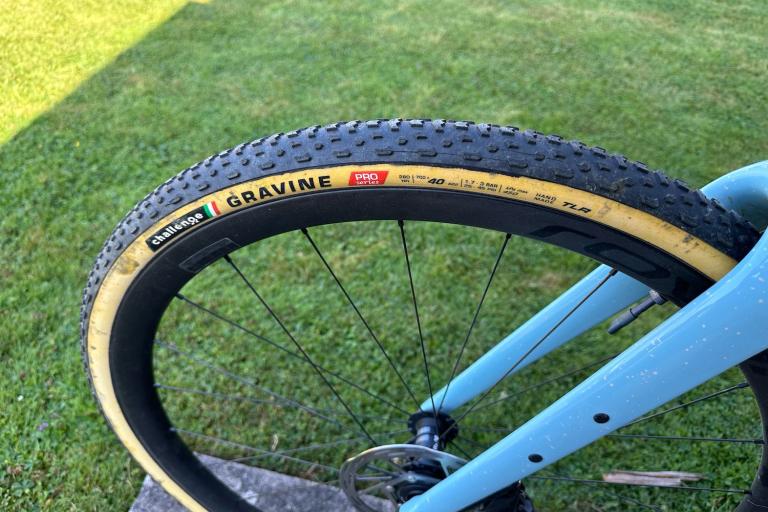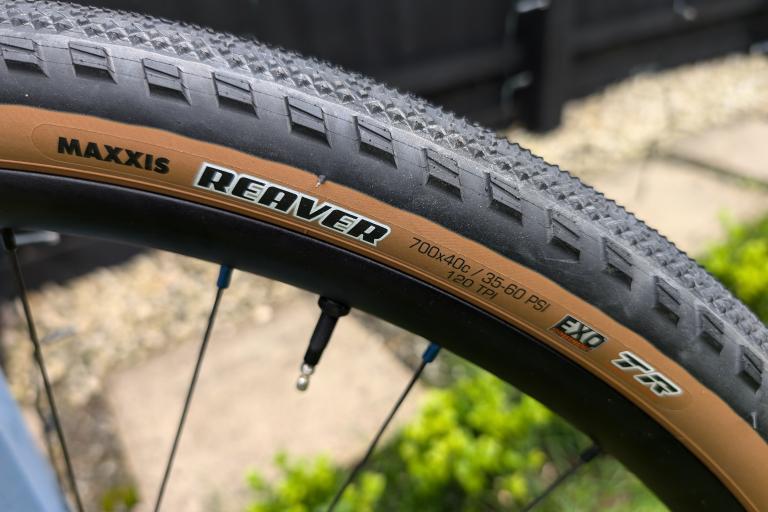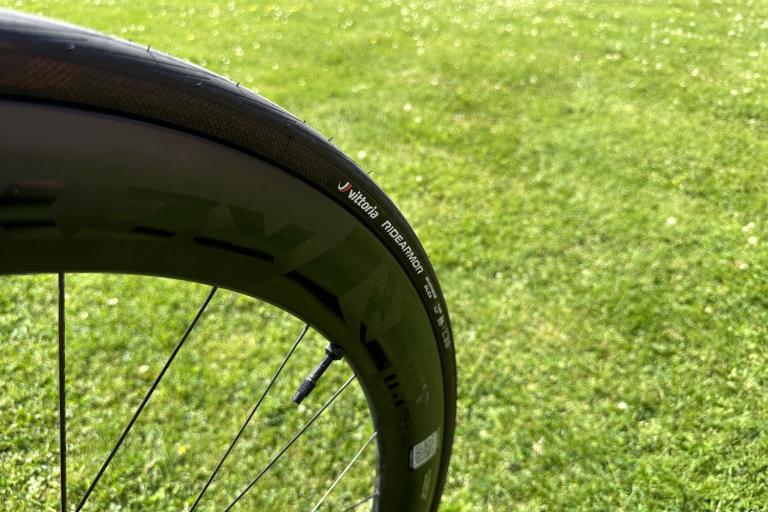- News
- Reviews
- Bikes
- Accessories
- Accessories - misc
- Computer mounts
- Bags
- Bar ends
- Bike bags & cases
- Bottle cages
- Bottles
- Cameras
- Car racks
- Child seats
- Computers
- Glasses
- GPS units
- Helmets
- Lights - front
- Lights - rear
- Lights - sets
- Locks
- Mirrors
- Mudguards
- Racks
- Pumps & CO2 inflators
- Puncture kits
- Reflectives
- Smart watches
- Stands and racks
- Trailers
- Clothing
- Components
- Bar tape & grips
- Bottom brackets
- Brake & gear cables
- Brake & STI levers
- Brake pads & spares
- Brakes
- Cassettes & freewheels
- Chains
- Chainsets & chainrings
- Derailleurs - front
- Derailleurs - rear
- Forks
- Gear levers & shifters
- Groupsets
- Handlebars & extensions
- Headsets
- Hubs
- Inner tubes
- Pedals
- Quick releases & skewers
- Saddles
- Seatposts
- Stems
- Wheels
- Tyres
- Health, fitness and nutrition
- Tools and workshop
- Miscellaneous
- Buyers Guides
- Features
- Forum
- Recommends
- Podcast
review
£131.99
VERDICT:
If tubulars are a must for any condition then these are hard to knock – apart from the price
Weight:
407g
Contact:
At road.cc every product is thoroughly tested for as long as it takes to get a proper insight into how well it works. Our reviewers are experienced cyclists that we trust to be objective. While we strive to ensure that opinions expressed are backed up by facts, reviews are by their nature an informed opinion, not a definitive verdict. We don't intentionally try to break anything (except locks) but we do try to look for weak points in any design. The overall score is not just an average of the other scores: it reflects both a product's function and value – with value determined by how a product compares with items of similar spec, quality, and price.
What the road.cc scores meanGood scores are more common than bad, because fortunately good products are more common than bad.
- Exceptional
- Excellent
- Very Good
- Good
- Quite good
- Average
- Not so good
- Poor
- Bad
- Appalling
Twelve weeks is possibly the longest I've spent testing one product, but with a price of £131.99 each for these Maxxis Velocita MS Tubular tyres I wanted to check Maxxis' claims about impressive puncture proofing and reliability. We've seen the scenery change and the weather conditions get poorer, but we've both come through unscathed.
Maxxis says the Velocitas are 'born from the cobbles of Roubaix', the yearly one-day race that takes place across the roads and cobbled farm tracks of Northern France. Known as one of the Classics, it's a stunning spectacle and brutal, both on the riders and, above all else, the bikes and kit.
> Find your nearest dealer here
Punctures are commonplace from hitting the hard edged pavé and the amount of debris on the tracks, especially if conditions are wet and muddy. For the Velocita tyres to counteract this, Maxxis has installed its MaxxShield layer from edge to edge to protect both the tread and sidewalls from damage.
According to its website, Maxxis first used its SilkShield layer, a secret squirrel exclusive material, before adding a Kevlar layer over the top. It adds to the weight, with these being 133g heavier than the 27mm Zipp Tangente tubulars they replaced, but even riding over every thorn in hedge cutting season I could find, the Velocitas were barely marked let alone punctured.
I've smacked through potholes too and found the roughest back lanes I could, all to no avail: the puncture fairy stayed away.
The Velocitas have quite a low thread count of 120tpi (threads per inch), which means they are a little less supple than most other race tyres; those Zipps they replaced have 320tpi. It takes a little away from the ride feel but even when pumped up to their 130psi maximum they are still smoother than a clincher and innertube setup.
Grip is impressive in both the wet and dry. There are loads of dimples and grooves making up the tread, which to be honest are pretty much pointless on a road tyre as it all comes down to the compound. Here, the compound has a tacky sort of feel to it when it's warm and doesn't seem to lose that when things dip below freezing.
They are confidence inspiring in the corners and if they do happen to lose traction it's very progressive, even from the front wheel. There's enough of a warning that you can adjust your bodyweight to avoid decking it.
Tubular sells
Fitting a tubular normally involves putting it on the wheel dry for a couple of days to stretch it, before glueing or taping it into position. This is a must for the Velocitas as they are as tight as hell – I had to employ the help of the good lady wife to stretch the last bit on.
Once on, though, they sit true – the sign of a well made tub in my experience; the cheaper and poorer quality they are, the more tweaking and adjusting they require to get them to run true. All while you're trying to beat the drying time of the glue.
> Tubular, tubeless, clincher? Your guide to road bike tyres
Another cool thing about the Velocitas is the valve. Most wheels that people are using tubs on these days are deep section, but the majority of tyres don't have removable valve cores to add an extension. The Velocitas come supplied with a 60mm anodised extension that screws on directly to the tub and if you need to go longer for time trial wheels of 80-100mm deep, for instance, then you can buy longer ones separately.
Value? You knew it was coming and probably made your own mind up at the start of the review, but I don't think the price is quite as astronomical as you might think. Bear with me...
Back in my time trialling days I'd happily blow 70 or 80 quid on a tub and often I'd get through two or three of those a season because of punctures. So a tub that I knew I would definitely (within reason) finish the race on would be a sensible investment. Not only that, the Velocitas also give you the confidence to go out for a training ride on your best wheels knowing that a puncture is likely to be rare. I suggest that, if we're honest, punctures are the main reason most of us don't use tubs.
Saying all that, the growth in tubeless tyres takes away a lot of the puncture risk, and although prices are still pretty steep for most tubeless tyres they are no way as high as these.
A tubular is completely different to any clincher in terms of ride feel and comfort, though, so for some it's the only option. It's up to you whether you think the cost of the Velocitas is justifiable over a cheaper tub and a can of Vittoria's Pit Stop sealant.
Verdict
If tubulars are a must for any condition then these are hard to knock – apart from the price
road.cc test report
Make and model: Maxxis Velocita MS Tubular Tyre
Size tested: 28mm
Tell us what the product is for, and who it's aimed at. What do the manufacturers say about it? How does that compare to your own feelings about it?
Maxxis says: "Born from the cobbles of Roubaix, the Velocita is a high-volume endurance racing tubular tire. A center diamond tread turns into a file tread on the edges of the Velocita for increased cornering control, while the MaxxShield gives puncture protection under the sidewalls and tread."
As far as puncture resistance goes they are hard to knock, though that does add to the weight.
Tell us some more about the technical aspects of the product?
Conditions: Racing, Sport
Puncture Protection: Level 4
TPI: 120
Ply Construction: Single
Compound: Dual
Max PSI: 130
Tech: Maxx Shield
Rate the product for quality of construction:
9/10
Rate the product for performance:
8/10
Rate the product for durability:
9/10
Rate the product for weight (if applicable)
7/10
Rate the product for comfort (if applicable)
8/10
Rate the product for value:
5/10
Yes expensive, but...
Tell us how the product performed overall when used for its designed purpose
The Velocita is designed as a race tyre that will take on whatever conditions it is faced with. Rolling resistance is pretty good and puncture resistance is near faultless.
Tell us what you particularly liked about the product
Their robustness.
Tell us what you particularly disliked about the product
The price.
Did you enjoy using the product? Yes
Would you consider buying the product? Hmm... to guarantee I'd finish every race I'd consider them.
Would you recommend the product to a friend? Yes
Use this box to explain your score
Massively expensive and massively impressive, but only you can decide whether they are worth the money. For me, as someone who has to run the gauntlet with tubular tyres on test bikes in the winter, I can certainly see the appeal.
About the tester
Age: 38
I usually ride: This month's test bike My best bike is: Kinesis Aithien
I've been riding for: 10-20 years I ride: Every day I would class myself as: Expert
I regularly do the following types of riding: time trialling, commuting, club rides, sportives, fixed/singlespeed
Since writing his first bike review for road.cc back in early 2009 senior product reviewer Stu has tested more than a thousand pieces of kit, and hundreds of bikes.
With an HND in mechanical engineering and previous roles as a CNC programmer/machinist, draughtsman and development engineer (working in new product design) Stu understands what it takes to bring a product to market. A mix of that knowledge combined with his love of road and gravel cycling puts him in the ideal position to put the latest kit through its paces.
He first made the switch to road cycling in 1999, primarily for fitness, but it didn’t take long for his competitive side to take over which led to around ten years as a time triallist and some pretty decent results. These days though riding is more about escapism, keeping the weight off and just enjoying the fact that he gets to ride the latest technology as part of his day job.
Latest Comments
- Rendel Harris 11 min 25 sec ago
The Specialized Tricross (of which I own an example, used for winter commuting, a bit of trails and general errand running (and occasional long...
- Keesvant 1 hour 46 min ago
Wish i had a camera, spotted a bus-driver. Driving a bus full of people using her phone while driving yesterday.
- espressodan 2 hours 29 min ago
Japan is a very compliant, low crime society....
- Born_peddling 3 hours 35 min ago
Athletes will always be that it's the technology through the years that's pushed time trials and race times. As a former downhill rider (for fun) I...
- Hirsute 7 hours 4 min ago
Genuinely remorseful https://www.bbc.co.uk/news/articles/crmz74v9z3eo Failed to stop.
- David9694 7 hours 10 min ago
Live: Car crashes into Sainsbury's petrol station kiosk at The Willows...
- Hirsute 7 hours 13 min ago
Hope it's at least a 3 season bag.
- Tom_77 10 hours 31 min ago
Looking at some of my local byelaws, many of them are phrased along the lines of:...
- wtjs 10 hours 32 min ago
car is costly but once the tax etc is paid (which you can't avoid - well, outside of Lancs...)...







Add new comment
8 comments
Ha!
". . . even when pumped up to their 130psi maximum they are still smoother than a clincher and innertube setup."
I'm calling complete BS on this. There is zero chance that a 130psi tubular feels better than a 80psi high quality clincher. I almost exclusively race tubulars, and very nice 320tpi ones at that, and this idea that the ride of a tubular is magical is pretty much a joke. I race tubulars because I can run them at lower pressures than similar clinchers, giving me a bigger traction patch on the ground. It's nearly impossible to pinch-flat a tubular, and, if you do puncture, a well glued tubular stays on the rim at 45mph, giving a semblance of control as you try to keep upright while slowing down.
No, a 130psi tubular does not feel better than an open tubular at 40 or 50 psi less, especially not a chunky, heavy all-conditions tubular.
Why on earth would you put 130psi in them? I run my Pave tubs at 80-85 as a 70kg rider, going by the usual formula you'd need to be about 200kg to need to run 130psi in a 27mm tyre. Seems just a bit excessive.
Other than that the main reason to ride tubs is the ride quality which I'd imagine is awful thanks to the thickness and reinforcement in the sidewalls.
Yet another solution to a non-problem as brought to you by the cycling industry.
Now, correct me if I'm wrong, but I believe that these tyres were being tested by a product tester working for a website that tests & reviews cycling products and bikes. Therefore, it makes sense to test them at various pressures on various surfaces in various conditions. Does that really need outlining?!
Interesting that he only mentions pumping them up to max. not 'but at my usual 75 psi they rode just as badly as Conti Gatorskins'. Bit of a review fail if you don't mention the conditions that are actually normal, especially if you also run them as a pointless high pressure.
There are plenty of people still using the table on the side of a tyre as a target rather than a maximum.
I just fitted two new high-end tyres to my Ferrari, admittedly the cheaper fronts rather than the monster rears, for less than the cost of two of these BICYCLE tyres. Utter madness.
the most important point - for whom would spending £260 on tyres benefit? only the manufacturer surely, thats just ridiculous at anything below pro level
John stevensson, in his 4th November road.cc article, claims 120 tpi is as high as is ever used. Manufacturers claiming a higher tpi count are generally adding together the thread-count of the different plys. The above review suggests otherwise.
Discuss.
Question: Were you confident enough in these to ride without carrying a pump and sealant?